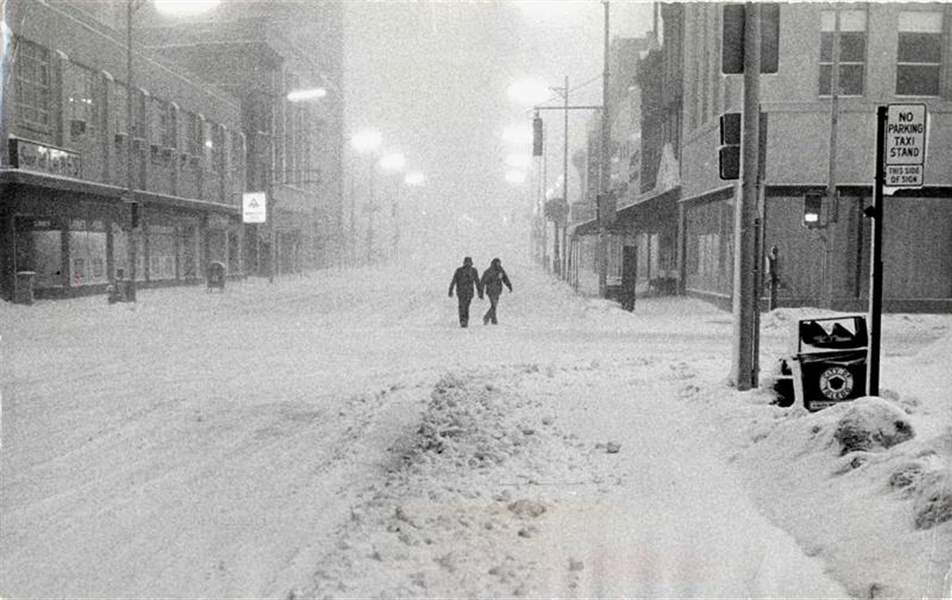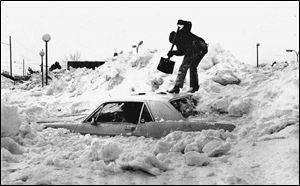
Storm triggers memories of '78
2/20/2007
A view to the west at Adams and Huron streets is typical of downtown Toledo s ghostliness as the storm swirled.
Last week's big Valentine's Day snowstorm was certainly a nuisance to residents of the Toledo area, and it was costly to businesses like florists and many restaurants. It pretty much shut the city down for a day.
But it was still nothing like the Blizzard of 1978, which 29 years ago virtually paralyzed northwest Ohio and southeast Michigan for three to four days, and even longer in some neighborhoods.
Businesses coped with the unbelievable weather - 53-miles-per-hour winds that whipped 13 inches of snow into 16-foot drifts - in pretty inventive ways. And many Toledo consumers learned some important survival skills.

Twenty-nine years ago, winds of 53 miles an hour whipped 13 inches of snow into 16-foot drifts.
That storm, the result of the collision of two massive weather fronts, produced some extraordinary examples of camaraderie and esprit de corps. Many businesses and workers went the extra mile to help others out.
For example, hotels and motels did double duty: They not only housed, fed, and entertained thousands of stranded motorists and business people, but they also served as emergency shelters for the Ameri-can Red Cross (its 55 locations in the region also included the Sports Arena).
Supermarket and restaurant workers gamely kept many places open even though the shelves became bare at times. The Red Cross used the Kroger store at Swayne Field as an emergency supplier of food and supplies for snowed-in nursing homes, trailer courts, and apartment complexes.
Workers at a Frisch's restaurant near the Anthony Wayne Bridge stayed on the job overnight to prepare food for Toledo Edison crews and law-enforcement agencies.
A Johns-Manville fiberglass plant in Waterville got food to 28 stranded workers by snowmobiles and four-wheel-drive vehicles.

A view to the west at Adams and Huron streets is typical of downtown Toledo s ghostliness as the storm swirled.
Nurses in some area hospitals worked 16 straight hours the first day of the storm. In the days after the storm, private contractors pitched in to help clear 1,000 miles of city streets, and owners of private helicopters donated their craft to help out where needed.
The blizzard started in the wee hours of the morning of Thursday, Jan. 26, 1978. After a heavy rain, snow started falling as the temperature dropped to 11 degrees.
Seven inches piled up in the first 7 hours. TARTA was out of commission for four days. Toledo Express Airport shut down for three days. Amtrak couldn't get any trains in or out for more than two days.
About 30,000 Toledo Edison customers lost power, and at least 6,000 of them had no electricity for three days or more.
Downtown Toledo was a ghost camp, except for emergency crews, The Blade, a few restaurants, and the hotels - the Commodore Perry Motor Inn, the Hillcrest Hotel, and the Holiday Inn Downtown.
Despite the adversity, The Blade continued to publish, although it printed far fewer copies than usual.
Many of us Blade employees walked miles to work, or thumbed rides in four-wheel vehicles.
When we got to work, we couldn't get home: The Blade rented dozens of rooms at the Commodore Perry, and brought in a mobile kitchen to serve sandwiches, coffee, and soft drinks at the newspaper.
Hundreds of Toledoans who owned recreational vehicles did their part. Snowmobilers and four-wheelers delivered groceries and medical supplies.
After about four days, most of Toledo had dug out - thanks partly to help from the Ohio National Guard and from about 400 regular Army troops and heavy equipment flown in after President Carter declared a state of emergency for the Toledo area.
Some called the Blizzard of '78 a "storm of the century." Most of us who survived it would be happy to wait another 71 years for another like it.